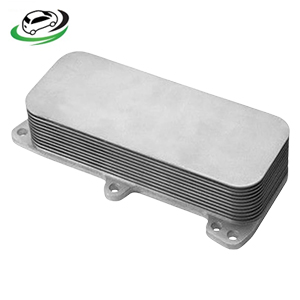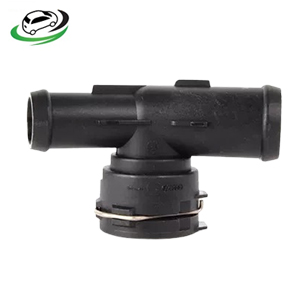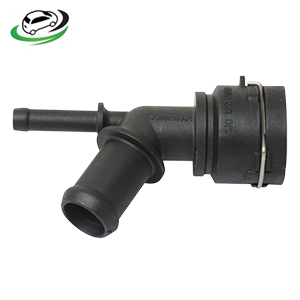Get Radiator Coolant Hose Adapter Volkswagen Golf IV 2.0 / Jetta IV 2.0 / New Beetle-2.5L/TDI 1J0122291B
The radiator coolant hose adapter is a crucial component in the engine cooling system, playing a key role in the efficient transfer of coolant between different parts of the engine. This guide provides an in-depth look at the radiator coolant hose adapter, including its function, construction, types, symptoms of issues, diagnosis, and replacement.
What is a Radiator Coolant Hose Adapter?
A radiator coolant hose adapter is a fitting used to connect and adapt various coolant hoses within the engine’s cooling system. It allows for the proper routing and connection of hoses to the radiator, engine, and other cooling system components. The adapter is designed to accommodate different hose sizes and configurations, ensuring a secure and leak-free connection in the cooling system.
Functions of the Radiator Coolant Hose Adapter
The radiator coolant hose adapter serves several essential functions in the cooling system:
- Connecting Hoses: The primary function of the coolant hose adapter is to connect different coolant hoses. It ensures that coolant flows smoothly between the radiator, engine, water pump, and other components, maintaining proper cooling system operation.
- Adapting Hose Sizes: The adapter allows for the connection of hoses with different diameters or configurations. This adaptability is crucial in engines with complex cooling systems or when upgrading to aftermarket components.
- Preventing Leaks: A properly installed coolant hose adapter helps prevent coolant leaks by providing a secure and tight connection between hoses. This prevents loss of coolant and maintains the engine’s cooling efficiency.
- Maintaining Cooling Efficiency: By ensuring proper hose connections and flow, the adapter helps maintain the engine’s cooling efficiency. This is critical for preventing overheating and ensuring optimal engine performance.
- Facilitating Maintenance and Repairs: The adapter makes it easier to perform maintenance and repairs on the cooling system. It allows for the easy removal and replacement of hoses and components without disturbing the entire system.
Construction of the Radiator Coolant Hose Adapter
The radiator coolant hose adapter is typically constructed from durable materials that can withstand the harsh conditions of the engine cooling system. Key components of the adapter include:
- Adapter Body: The adapter body is the central component that connects the hoses. It is usually made from materials like aluminum, steel, or high-quality plastic. The body may have different shapes and sizes to accommodate various hose configurations.
- Hose Fittings: The hose fittings are designed to securely connect the coolant hoses to the adapter. They may include barbs, threads, or clamps to ensure a tight and leak-free connection.
- Sealing O-Rings or Gaskets: Many coolant hose adapters include sealing O-rings or gaskets to prevent leaks. These seals are made from materials like rubber or silicone and are designed to withstand high temperatures and pressure.
- Mounting Points: Some adapters have mounting points or brackets to secure them in place. These mounting features ensure that the adapter remains stationary and properly aligned within the cooling system.
- Connection Ports: The adapter has connection ports for the coolant hoses. These ports may vary in size and configuration, depending on the specific design of the adapter and the cooling system requirements.
Types of Radiator Coolant Hose Adapters
Radiator coolant hose adapters come in various types and configurations, depending on their application and design. Common types include:
- Straight Adapters: Straight adapters have a simple, straight design and are used to connect hoses of the same diameter. They are commonly used in straightforward hose connections where no changes in hose direction or size are required.
- Elbow Adapters: Elbow adapters have a 90-degree bend and are used to connect hoses that need to change direction. They are useful in situations where space is limited or when routing hoses around other engine components.
- Tee Adapters: Tee adapters have three connection points and are used to split the coolant flow into two separate hoses. They are commonly used in cooling systems that require the distribution of coolant to multiple components.
- Reducer Adapters: Reducer adapters are designed to connect hoses of different diameters. They gradually reduce the size of the hose connection, allowing for the smooth transition between different hose sizes.
- Custom Adapters: Custom adapters are specifically designed for unique applications or modifications. They may be custom-made to fit specific cooling system configurations or to accommodate aftermarket components.
Symptoms of Issues with the Radiator Coolant Hose Adapter
Problems with the radiator coolant hose adapter can lead to various symptoms affecting engine performance and cooling efficiency. Common symptoms include:
- Coolant Leaks: Leaks around the adapter can indicate a problem with the adapter or its connections. Coolant leaks may result in low coolant levels, overheating, and potential engine damage.
- Overheating: A faulty adapter can disrupt the flow of coolant, leading to engine overheating. Symptoms of overheating include a high temperature gauge reading, steam from the engine, or a check engine light indicating cooling system issues.
- Low Coolant Levels: If the adapter is leaking or not properly connected, it can cause a loss of coolant. Low coolant levels can lead to inadequate cooling and potential engine overheating.
- Unusual Engine Noises: Air trapped in the cooling system due to a faulty adapter can cause unusual engine noises, such as gurgling or bubbling sounds. These noises may indicate a problem with the coolant flow.
- Poor Heater Performance: If the adapter is not functioning properly, it can affect the flow of coolant to the heater core, resulting in reduced heater performance or inconsistent cabin temperature.
Diagnosing Issues with the Radiator Coolant Hose Adapter
Diagnosing issues with the radiator coolant hose adapter involves several steps:
- Visual Inspection: Perform a visual inspection of the adapter and its connections. Look for signs of coolant leaks, damage, or corrosion. Check the sealing O-rings or gaskets for wear or deformation.
- Check Coolant Levels: Monitor the coolant levels in the radiator and overflow reservoir. Low coolant levels can indicate a leak or problem with the adapter.
- Inspect Hose Connections: Check the hose connections to the adapter for tightness and security. Ensure that the hoses are properly aligned and seated on the adapter.
- Pressure Test: Use a cooling system pressure tester to check for leaks in the cooling system. The pressure test can help identify leaks around the adapter or other components.
- Check Engine Temperature: Monitor the engine temperature using the temperature gauge or diagnostic tool. High engine temperatures may indicate a problem with the coolant flow or adapter.
Replacing the Radiator Coolant Hose Adapter
If a problem with the radiator coolant hose adapter is identified, replacing it is necessary to restore proper cooling system function. The replacement process typically involves the following steps:
- Prepare the Vehicle: Ensure the engine is cool before starting the replacement process. Disconnect the battery to prevent electrical issues. Drain the coolant from the radiator and cooling system.
- Locate the Adapter: Locate the radiator coolant hose adapter in the engine compartment. The adapter is usually positioned where coolant hoses connect to the radiator or engine.
- Remove the Old Adapter: Disconnect the coolant hoses from the old adapter. Remove any mounting bolts or fasteners securing the adapter in place. Carefully extract the old adapter from its mounting location.
- Install the New Adapter: Position the new radiator coolant hose adapter in the mounting location, ensuring proper alignment with the coolant hoses. Secure the adapter with the appropriate bolts or fasteners.
- Reconnect Coolant Hoses: Reconnect the coolant hoses to the new adapter. Ensure that the hoses are properly aligned and securely connected.
- Refill Coolant: Refill the radiator and cooling system with the appropriate type and amount of coolant. Bleed the cooling system if necessary to remove any air pockets.
- Check Operation: Start the engine and monitor the cooling system for any signs of leaks or issues. Check the coolant levels and ensure that the engine operates within the normal temperature range.
Choosing the Right Radiator Coolant Hose Adapter
When selecting a replacement radiator coolant hose adapter, consider the following factors:
- OEM vs. Aftermarket: OEM (Original Equipment Manufacturer) adapters are designed to meet the exact specifications of your vehicle and provide reliable performance. Aftermarket adapters can vary in quality, so choose a reputable brand if opting for an aftermarket part.
- Compatibility: Ensure that the adapter is compatible with your vehicle’s make, model, and engine configuration. Verify the part number and specifications before making a purchase.
- Material and Design: Choose an adapter made from durable materials that can withstand the engine’s operating conditions. Consider the design of the adapter, including its hose fittings and sealing features, to ensure proper fit and function.
Follow us on Facebook for more parts.



